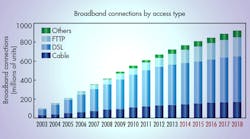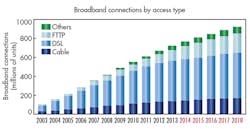This file type includes high resolution graphics and schematics when applicable.
From 4K TV content, interactive gaming, streaming video, and remote monitoring in the home to high-bandwidth cloud applications for small businesses, gigabit broadband can substantially boost average data rates to the home. Not only does this increase in bandwidth help lessen a gap between current demand and actual services, it promises to open the floodgates to new ideas and applications unrestricted by the high-latency, low-data-rate access of the past.
Various technologies will be used to rapidly deploy gigabit broadband. This article will take a closer look at the implementation approaches, including fiber, G.fast for DSL, PON, and DOCSIS 3.1.
Consumers always want more—more device memory, more megapixels, and faster Internet service. According to a recent survey, more than half of consumers are unsatisfied with their broadband speeds (in 2014, the average American broadband speed was 11.5 Mb/s). For the first time, consumers and developers can experience unprecedented speeds with gigabit broadband to the home (GTTH).
Gigabit-speed broadband is needed for several reasons. First, various sources predict that the average household will have 10 connected devices by 2020. The devices will run a variety of bandwidth-intensive apps, all of which will benefit from higher broadband speeds, e.g., online gaming, over-the-top (OTT) video streaming, cloud data transfers, home monitoring, etc.
Further, the move to gigabit networks comes just in time for the rollout of ultra-high-definition (Ultra HD) broadcasts and content. With gigabit broadband, seamless streaming of 4K video content will be possible to multiple devices, with plenty of bandwidth to spare. For example, streaming up to three 4K TVs in one household requires only 100 Mb/s, a rate easily managed by gigabit broadband.
There will be other more intriguing and imaginative applications of high-bandwidth pipes to the home than just 4K video or interactive gaming. For example, the Pew Research Center’s 2014 report, Killer Apps in the Gigabit Age, includes several provocative highlights such as integrated daily life logging; telepresence remote sharing of holidays; realistic virtual conferencing; two-way, persistent video; and life-like interactions with doctors and educators.
Enabling Gigabit to the Home (GTTH)
Successfully supporting rising demand for gigabit-speed broadband networks will require a number of implementation technologies, from fiber and G.fast for DSL to PON and DOCSIS 3.1 (see the figure). According to a recent report from Infonetics Research, the global broadband aggregation equipment market, including Ethernet fiber to the home (FTTH), DSL, and PON, finished 2014 on a strong note, with fourth-quarter 2014 revenue growing 7% sequentially to $2.2 billion.
In terms of DOCSIS 3.1, which is the latest standard used for ultra-high speed Internet via cable, some of the biggest operators in the U.S. and Europe have pledged rollouts within the coming year.
To better understand the roadmap for gigabit broadband roll-outs, let’s consider the pros and cons of the leading implementation technologies of fiber-to-the-home (FTTH)—G.fast for DSL, passive optic network (PON), and DOCSIS 3.1.
Fiber
Nothing is faster than the speed of light, right? That’s why fiber-optics can operate at much higher frequencies and with much larger data capacity than electronic systems. Fiber offers much faster speeds over much longer distances than traditional copper-based technologies such as DSL and cable.
The biggest drawback with new fiber networks is the cost differential for replacing existing equipment and laying new fiber-optic lines when old infrastructures such as DSL and cable are still serving customers. For this reason, the adoption of FTTH has been relatively slow. Even Google’s Fiber program has been restricted to a handful of carefully selected cities to ensure profitability.
Two main approaches are employed for FTTH delivery. One uses a point-to-point (P2P) Ethernet network that provides each user with a dedicated optical channel. The other approach uses a passive optical network (PON), which offers point-to-multipoint connectivity that greatly improves the efficiency of existing fiber infrastructure. Two variations of PON exist: Ethernet PON (EPON) and Gigabit PON (GPON).
The challenges in balancing the cost of laying new fiber lines while utilizing existing copper and cable infrastructures has led many ISPs to pursue a mixed solution in deploying gigabit broadband. One example brings fiber close to a building to be terminated next to an existing DSL modem. Signals are carried to subscribers using one of the newer variants of DSL—VDSL2 or G.Fast.
Some cable-TV operators favor a hybrid fiber-coax (HFC) architecture. Here, fiber connects to a coaxial cable that serves a home or business. This hybrid network typically uses DOCSIS (Data over Cable Service Interface Specification) technology for Internet access. A new version of this technology, DOCSIS 3.1, moves the DOCSIS closer to end users.
G.Fast for DSL
G.fast, an emerging standard from the International Telecommunication Union (ITU), will deliver gigabit speeds over existing copper lines. Digital Subscriber Line (DSL) represents the largest segment of the wire-copper-line broadband market, far exceeding both FTTH and cable deployments. Much of the world doesn't have cable-TV infrastructure at all, and still less of it has fiber-optic connections. Thus, phone networks are widely used and cover about 500 million DSL subscribers globally in 2015, according to analyst firm IHS.
The downside to high-speed DSL networks is that gigabit speeds are only practical over relatively short distances and on relatively disturber-free lines between the provider’s fiber node and the customer. Longer distances and disturbers affect the signal quality. Furthermore, the telecommunications industry is still installing very high-speed DSL (VDSL), the G.fast predecessor. The 1 Gb/s offered by G.fast provides significantly faster speeds than VDSL, though it’s restricted to shorter loop lengths. Even as VDSL is completing its installation cycle, the first stage of the next transition—G.fast—has begun with the arrival of chips from the major suppliers.
The Broadband Forum industry consortium recently wrapped up a G.fast equipment plug-fest as part of its ongoing program to drive widespread G.fast certification. The G.fast plug-fest provided vendors developing remote distribution point units (DPUs) and customer premises equipment (CPE) an opportunity to test and benchmark the interoperability of their products prior to full certification testing.
PON
Another broadband access technology is a passive optical network or PON, a fiber-based network that uses only fiber and passive components and typically costs much less than traditional active electronic component networks. PON enables a single optical fiber to serve multiple premises, thus reducing the amount of fiber and equipment needed in comparison to point-to-point fiber architectures.
Carriers around the world who continue to roll out fiber networks are using PON as the main deployment technology. While Europeans favor a fiber-based, point-to-point Ethernet (P2P) network, GPON is already the dominant technology choice in North America. Asia saw significant Ethernet (EPON) deployments in Japan and South Korea, and China—the world’s largest FTTH market—recently embarked on a large-scale deployment using a mix of EPON and GPON.
NG-PON2 technology, driven by the Full Service Access Network industry group, promises to deliver 40 Gb/s of shared downstream capacity, compared with the 2.5 Gb/s provided by current GPON systems. The fiber broadband technology is in the final stages of being standardized by the ITU Telecommunication Standardization Sector and enabled by TWDM-PON (TDM/WDM-PON), a hybrid system that stacks four 10-Gb/s GPONs on to a single fiber.
DOCSIS 3.1
The DOCSIS 3.1 specification allows operators to exceed gigabit speeds on existing cable networks while simultaneously improving operational efficiencies. Technology using this standard will bring nearly a 100X increase in the average data rate to the home.
The standard itself was developed at record speed as cable companies started to consider gigabit rollouts of their own. DOCSIS 3.1 will enable 10 Gb/s down and 1 Gb/s up over existing cable. On the wireless side, when combined with 4x4 multi-user 5G Wi-Fi (802.11ac) devices, speeds of up to 2 Gigabits are obtainable with increased reach and range in any room. This will be a huge benefit for wireless streaming-video technology used in home gateways and STBs.
Operators such as AT&T, Comcast, Cox Communications, and Liberty Global have already embraced DOCSIS 3.1, with plans to deploy the technology on a broad scale in 2016.
Regardless of the implementation technique, gigabit (broadband) to the home will soon become commonplace, which will radically alter how consumers currently apply and interact with technology, and create avenues to innovation and applications that have yet to be explored. Gigabit speeds have the potential to improve education and distance learning, close the digital divide by providing equal access to all, and extend online healthcare to remote areas, all while accelerating economic development.



